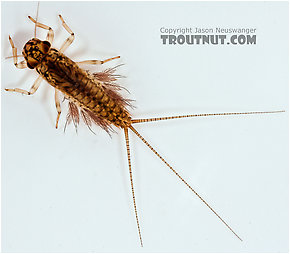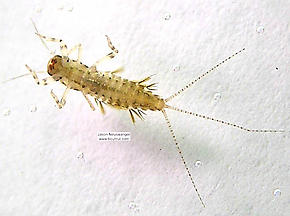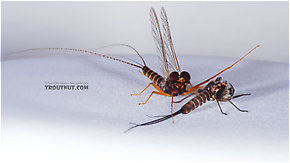Blog & Latest Updates
Fly Fishing Articles
Insects by Common Name


Mayfly Species Leptophlebia cupida (Borcher Drake)
Taxonomic Navigation -?-
Kingdom
Animalia (Animals)
» Phylum
Arthropoda (Arthropods)
» Class
Insecta (Insects)
» Order
Ephemeroptera (Mayflies)
» Species cupida (Borcher Drake)
Common Names
See the main Leptophlebia page for details about their nymphs, hatching, and egg-laying behavior. This is by far the most important species of that genus.
Where & When
Regions: East, Midwest, West
Time Of Year (?): Late April through May in the East; late May through June in the West
Preferred Waters: Both rivers and lakes
Leptophlebia cupida is most important in the East and Midwest. Its range was expanded into the West when a Western species called Leptophlebia gravastella was discovered to be a synonym (Synonym: A former name of a taxon, usually a species. Entomologists frequently discover that two insects originally described as different species are one in the same, and they drop one of the names. The dropped name is said to be a synonym of the remaining name. These changes take a while to trickle into the common knowledge of anglers; for example, Baetis vagans is now a synonym of Baetis tricaudatus.) of cupida. There are fishable hatches on select rivers in both the East and the Midwest.Time Of Year (?): Late April through May in the East; late May through June in the West
Preferred Waters: Both rivers and lakes
Very sporadic stragglers may emerge throughout the rest of the summer, but they are not important to trout.
Pictures of 17 Mayfly Specimens in the Species Leptophlebia cupida:
Leptophlebia cupida (Borcher Drake) Mayfly Nymph View 8 Pictures
View 8 Pictures
 View 8 Pictures
View 8 PicturesCollected March 29, 2005 from Fall Creek in New York
Added to Troutnut.com by Troutnut on April 6, 2006
Added to Troutnut.com by Troutnut on April 6, 2006
Leptophlebia cupida (Borcher Drake) Mayfly Nymph View 7 Pictures
View 7 Pictures
 View 7 Pictures
View 7 PicturesCollected January 13, 2004 from the Namekagon River in Wisconsin
Added to Troutnut.com by Troutnut on January 25, 2006
Added to Troutnut.com by Troutnut on January 25, 2006
Male Leptophlebia cupida (Borcher Drake) Mayfly Dun View 6 PicturesThis Leptophlebia cupida dun was extremely cooperative, and it molted into a spinner for me in front of the camera. Here I have a few dun pictures and one spinner picture, and I've put the entire molting sequence in an article.
View 6 PicturesThis Leptophlebia cupida dun was extremely cooperative, and it molted into a spinner for me in front of the camera. Here I have a few dun pictures and one spinner picture, and I've put the entire molting sequence in an article.
 View 6 PicturesThis Leptophlebia cupida dun was extremely cooperative, and it molted into a spinner for me in front of the camera. Here I have a few dun pictures and one spinner picture, and I've put the entire molting sequence in an article.
View 6 PicturesThis Leptophlebia cupida dun was extremely cooperative, and it molted into a spinner for me in front of the camera. Here I have a few dun pictures and one spinner picture, and I've put the entire molting sequence in an article.Collected May 27, 2005 from the Teal River in Wisconsin
Added to Troutnut.com by Troutnut on May 16, 2006
Added to Troutnut.com by Troutnut on May 16, 2006
Leptophlebia Nymph
Starring: Leptophlebia cupida Mayfly Nymph
In angling books, Leptophlebia mayfly nymphs have a reputation as poor swimmers. In reality, they're very adept swimmers, much moreso than most other mayfly nymphs categorized as "crawlers."
Recent Discussions of Leptophlebia cupida
Southeast Mayflies 24 Replies »
This is one of the species that seem to be prevalent in our area of southwest NC. It emerges in March as I recall and again in October on certain streams. I would like to confirm that this next season.
ReplyYour Thoughts On Leptophlebia cupida:
Top 10 Fly Hatches
Top Gift Shop Designs
Eat mayflies.
Top Insect Specimens
Miscellaneous Sites
Troutnut.com is copyright © 2004-2024 Jason
Neuswanger (email Jason). See my FAQ for information about use of my images.
 privacy policy
privacy policy
